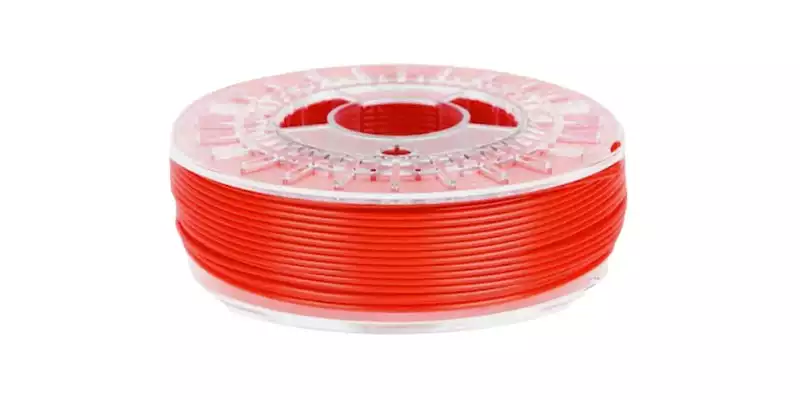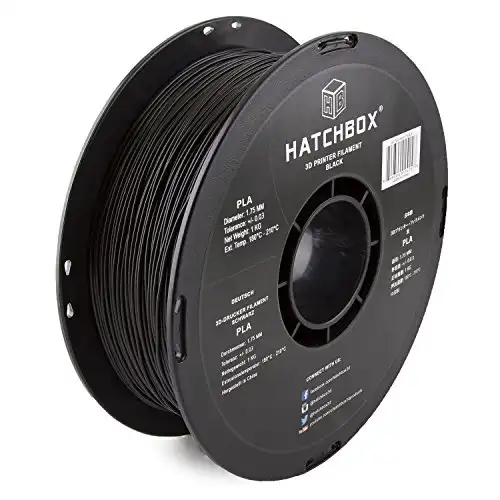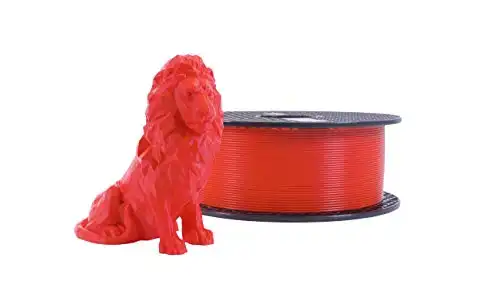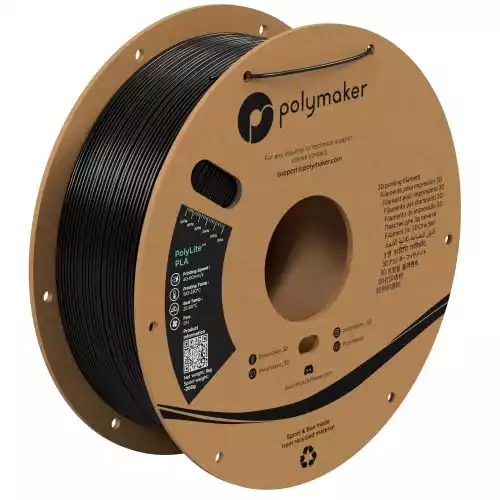In this guide, we’ll walk you through the most reliable, durable, and easy to use filaments for printing miniatures to give you the best tools available to print the best quality miniatures using an FDM printer.
While you’ll never get the same results as a resin printer, these filaments will help you get the best print quality from your minis:
|
|
|
|
|
4.2
|
4.1
|
4.2
|
|
N/A
|
$24.99 ($0.71 / Ounce)
|
N/A
|
These high-quality filaments help bring out those tough-to-print details and improve the look of your final results, setting you up for an easier time when it comes to painting.
Quick Overview
Which Filament Is Best for 3D Printing Miniatures?
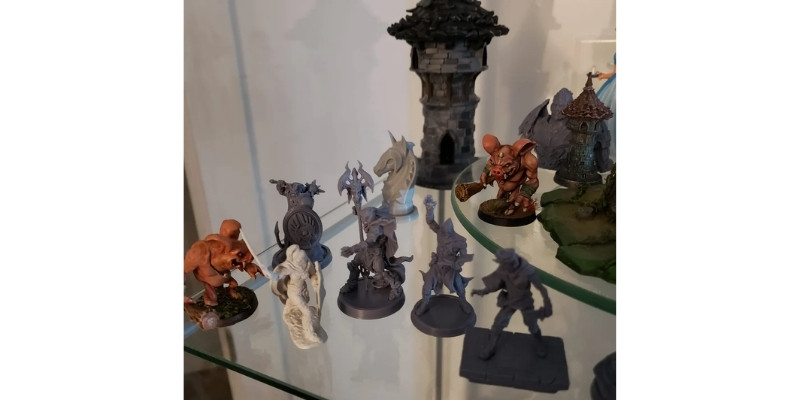
Among the available FDM filaments, PLA and PLA+ are the best filaments for 3D printing miniatures. What makes PLA such an attractive choice is its ease of use, reasonable durability coupled with slight flexibility, and the fact that it offers the best details of any FDM material.
Best Filament for 3D Printing Miniatures
1. ColorFabb PLA
- Price: $50 — Available at Matterhackers here
- Dimensional Tolerance: ±0.1 mm
- Colors: Over 200 colors + Color on Demand service
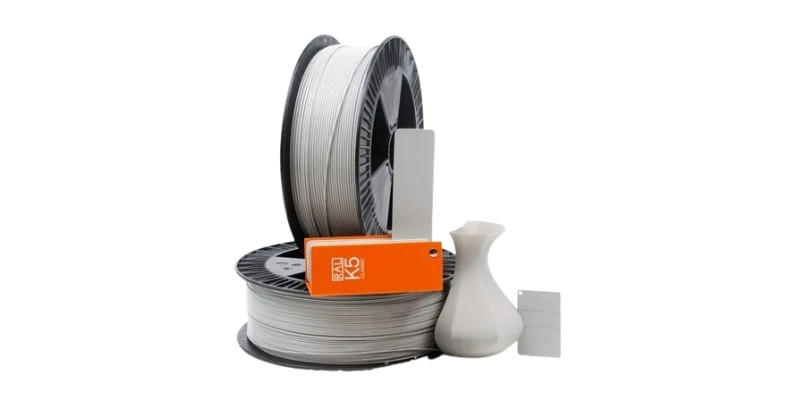
Pros
Resilient and durable.
Good adhesion and limited warping issues.
Great dimensional accuracies.
Cons
Some may find it to be too expensive.
ColorFabb PLA sets itself apart from other PLA because the formula used includes PHA, or Polyhydroxyalkanoate. This polyester makes the filament more resilient and durable than typical PLA, which makes it a strong option for miniatures subject to heavy usage and wear and tear.
It also helps promote better layer adhesion and limits warping issues, making ColorFabb PLA a real pleasure to work with as you’ll rarely encounter any issues linked to the quality of the filament.
Another appealing feature for miniature printing is that ColorFabb PLA is subject to a strict quality control regimen, offering one of the best dimensional accuracies out there. ColorFabb only accepts tolerances ±0.1 mm, meaning it’s one of the most consistent diameters available.
The tradeoff for all this guaranteed quality is that ColorFabb PLA doesn’t come cheap – around $50 a 750 g spool.
However, it’s worth paying this much when printing your most prized models to ensure they come off the bed looking as good as they can. It’s available in a broad range of colors, and ColorFabb even offers a Color on Demand service, which allows you to pick the exact color you want for your project.
Filament Diameter: 1.75mm | Weight: 0.75kg | Diameter Tolerance: ± 0.05 mm
2. eSun PLA+
- Price: Check latest price at Amazon here
- Dimensional Accuracy: ±0.03 mm
- Colors: Cold White, Bone White, White, Black, Grey, Silver, Brown, Light Brown, Fire Engine Red, Red, Magenta, Pink, Beige, Orange, Dark Yellow, Yellow, Pine Green, Green, Peak Green, Olive Green, Dark Blue, Blue, Light Blue, Purple
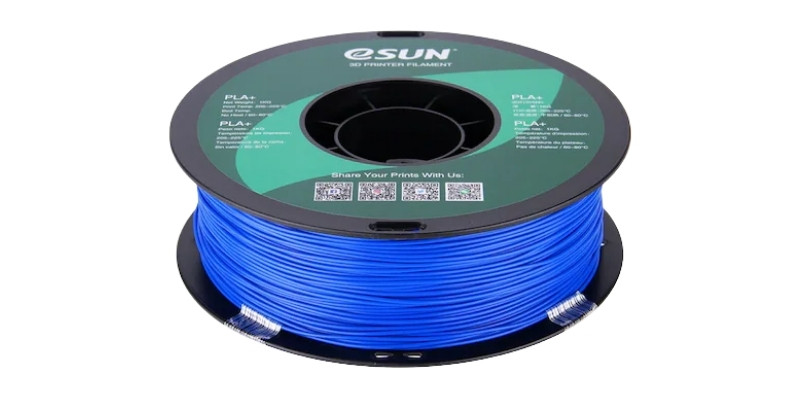
Pros
Good durability, impact resistance, and toughness.
Good layer adhesion and low instances of warping.
Cons
Dimensional accuracy is not as good as competitors.
eSun PLA+ takes standard PLA and spruces it up with a selection of additives to improve its durability, impact resistance, and toughness, ideal for ensuring your miniatures can withstand the heavy handling of any tabletop gaming session. eSun claims that its PLA+ can withstand 20% elongation at break, which is comparable to that of ABS.
Another benefit of the formula is better layer adhesion, low instances of warping and shrinkage, which itself makes the printing process easier, even for feature-heavy miniatures. Dimensional accuracy comes in at a respectable ±0.03 mm – not the best out there, but low enough to ensure the filament feeds consistently and smoothly into the printer for precise extrusion, and ultimately, a better final result.
While easy printing and solid miniature results are the main draw here, eSun PLA + is an affordable pick, with an asking price of between $20-$30 for a 1 kg spool. Over 20 colors also gives you plenty of options should you need variety for different miniature projects like the minis themselves, terrain, and accessories.
Color: Black | Dimensional Accuracy: +/- 0.03mm | Weight: 1kg Spool | Outside Diameter: 1.75mm
3. Hatchbox PLA
- Price: Check price at Amazon here
- Dimensional Accuracy: ±0.03 mm
- Colors: Black, White, Red, Blue, Silver, Orange, Gray, Glow in the Dark, Yellow, Green, Wood, Pink, Light Blue, Copper, Navy, Stone Granite, Mint Green, and many more

Pros
Cheap but reliable.
Strong results with a smooth finish.
Environmentally-friendly credentials.
Cons
Dimensional accuracy isn’t the best out there.
Hatchbox PLA flouts an army of devoted makers who swear by this cheap but reliable filament for all manner of projects, including filaments. The price is, of course, a big pull at $25 a 1 kg spool. It occupies the ground between dirt cheap filaments that are guaranteed to cause headaches and the premium options that are often too expensive for thriftier makers.
Despite being standard PLA, Hatchbox PLA produces particularly strong results with a special mention for the smoothness of the finish and the consistency of the coloring. Details also turn out well for what is an affordable filament, which makes it ideal for printing minis on a budget. The range of available colors is also staggering with dozens of options – if a color exists, Hatchbox PLA likely has it.
Hatchbox PLA boasts a decent ±0.03 mm dimensional accuracy, which sees it fall roughly on par with similarly priced filaments like eSun PLA. The PLA also stands out for its environmentally-friendly credentials, with Hatchbox guaranteeing that every spool is produced using a mixture of plant-based materials and polymers.
Color: Black | Diameter: 1.75mm | Weight: 1 KG Spool | Dimensional Accuracy: +/- 0.03 mm | Recommended Extrusion/Nozzle Temp: 180°C - 210°C (356°F - 410°F)
4. Polymaker PLA – Polylite and Polyterra
- Price: Check latest price at Amazon here
- Dimensional Accuracy: ±0.03 mm
- Colors: Black, White, Gray, Red, Navy, Green, Yellow, Orange, Teal, Purple, Banana, Candy, Mint Peach, Lava Red, Sapphire Blue, and more
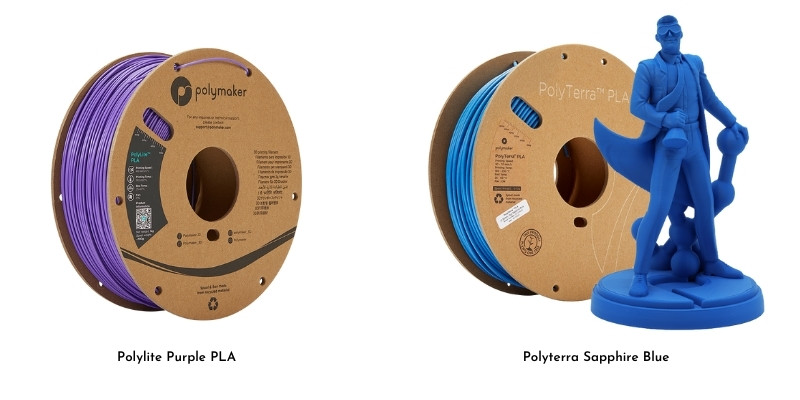
Pros
Reliable performance for a reasonable price.
Includes Jam-Free technology, improving stability.
Consistent results.
Cons
Some adhesion issues.
Polymaker is a well known manufacturer of filament, including PLA and a go to option for many makers out there. Polymaker uses the best raw materials for reliable performance that translates well to demanding miniatures, while also keeping costs reasonable at between $20-$30 a spool depending on the variant.
Notable among the Polymaker PLA range is Polylite PLA, a general-use PLA that’s affordable but also has some nice features including Polymaker’s Jam-Free technology that improves the heat stability of the filament to ensure uniform melting and therefore consistent extrusion with zero nozzle jams. While Polylite PLA will do well printing minis, its reasonable price and consistent results make it a strong option for printing terrain for D&D sets – you won’t feel too guilty churning through the filament.
You’ll find Polylite PLA in over ten different colors – not the most expansive, but the quality of the filament is the headline here. Every spool also comes with a reasonable bag and sandwiched in protective foam to keep it in top condition during shipping.
Consciousness makers will also find a lot to like in the Polyterra PLA variant when it comes to the efforts made by Polymaker to ease the impact of their PLA. The filament arrives with a cardboard spool for easy recycling and the company even plants a tree for every spool sold. There’s a real focus on minimizing the impact here while still giving miniature makers a quality filament to work with.
Polyterra also stands out for easy printing with few irritants like stringing and failed overhangs to sour the fun. It’s also marginally tougher than regular PLA, giving miniatures an extra bit of durability, which is always a benefit if you’re bringing them to multiple gaming sessions per week. Polyterra is available in a selection of regular colors and tasteful pastel colors.
Color: Black | Diameter: 1.75mm | Weight: 1kg | Nozzle / Bed Temperature: 210˚C / 50˚C
5. Prusament PLA
- Price: Check latest price at Amazon here
- Dimensional Accuracy: ±0.02 mm
- Colors: Galaxy Black, Azure Blue, Jet Black, Lipstick Red, Vanilla White, Lime Green, Gold, Royal Blue, Bronze, Gravity Grey, Opal Green, Pineapple Yellow, and many more
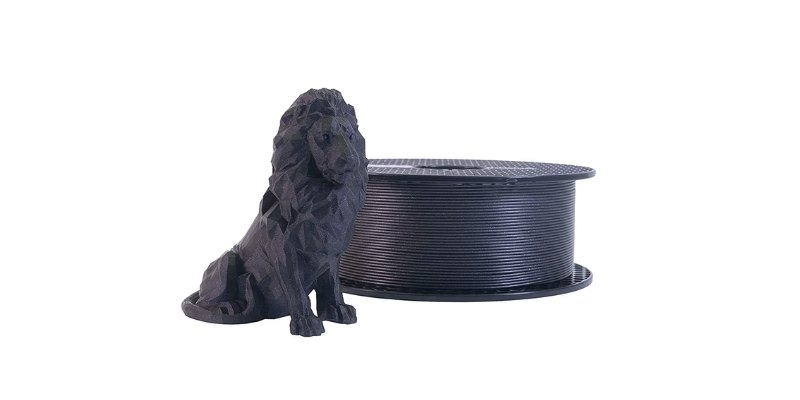
Pros
Easy to print.
Fantastic 0.02 dimensional accuracy.
Scannable QR code to check the parameters and test results of each spool.
Cons
Can sometimes cause jams.
Prusa Research is known for producing some of the best, and priciest, consumer 3D printers, notably the Prusa MK3S+. Prusament follows that same blueprint and stands as one of the best options for uncompromising miniature makers who want the best chance of producing high quality FDM printer models.
Prusa says that each spool is guaranteed to have a dimensionally accuracy of ±0.02 mm, which positions it as one of the most precise out there alongside ColorFabb. What this means is that each spool adheres to a strict standard that translates to less clogging or extrusion issues, important when printing detail-rich models with lots of small features like miniatures.
Prusament PLA is also odorless, low-warp, and a unique honeycomb patterned spool that requires less plastic to produce that filled-out spools found with other manufacturers. Each spool also comes with a QR code that leads to details about the production process, quality assurance testing, and other details about that specific bundle of PLA.
Though likely useless to many, this willingness to back up marketing claims with hard facts proves that Prusa is confident in the quality of every spool. This attention to detail also extends to the way each spool is wound, with none of the overlaps, tangles, or twists you so often get with ultra budget filament.
Paired with a well-tuned printer, Prusament PLA does well to minimize layer lines and every print bears a sleek smoothness that really does wonders to give a professional finish to miniatures even before they are painted.
What’s remarkable is that Prusament PLA is priced competitively despite being a premium offering, ranging from $25 to $30 depending on the color, of which there is a long list, including all the standard go-tos and lots of unique blends for those looking to venture off the beaten path.
Color: Lipstick Red | Diameter: 1.75mm | Weight: 1kg Spool (2.2 lbs) | Diameter Tolerance: +/- 0.02mm
Why is PLA Good For Miniatures?
As well as its ease of use and best-in-class details for an FDM filament, it costs less than other filaments, making it the cost effective option compared to other options like ABS and PETG. It’s also odorless, non-toxic, beginner-friendly (no enclosure or heated bed required), and is generally warp-free and less prone to layer adhesion issues.
PLA is also one of the best materials for printing miniatures as it responds particularly well to common post-processing steps like snipping, sanding, and priming. It’s also fairly porous so will take on paint well if prepared correctly.
PLA+ is effectively PLA but with a different formula, designed to increase its durability, stiffness, resistance, and strength. It tends to be more expensive, but retains all the attributes of standard PLA while being less brittle. It’s important to note that PLA+ is more of a blanket term than a specific, defined form of PLA. It’s best to view PLA+ as a family of improved materials based on PLA with additives like PHA and TPU.
Overall, the reason you’d want to opt for PLA+ is that it is markedly more resistant to pressure than straight PLA, which results in more flexibility before snapping or breaking. This can be particularly useful for miniatures used in D&D, tabletop gaming, and wargaming where that extra resistance should prolong the minis’ lifespan.
Alternative Filaments For Miniatures
If you’re comfortable with a small downgrade to the level of detail, ABS and PETG are also viable options for their extra durability and flexibility, especially if your minis will be subject to heavy use and are likely to be handled, dropped, and bashed regularly during gaming sessions.
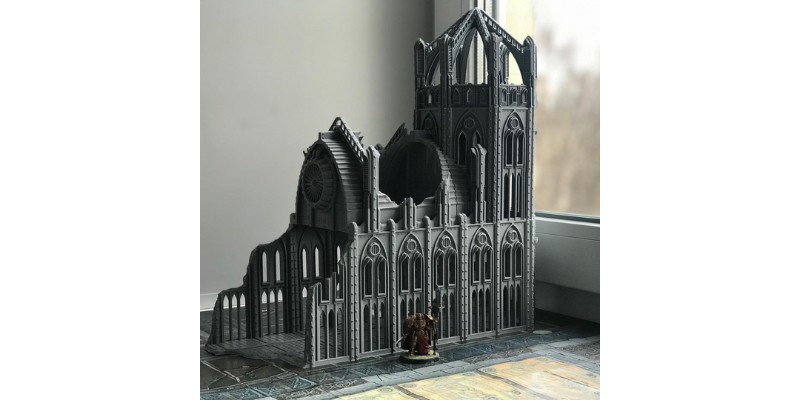
For decorative pieces or terrain, we recommend sticking with PLA or PLA+ if only to keep the costs racking up. Larger models require more filament and PLA remains the cheapest out there, so is the most cost-effective option, especially when factoring the failed prints and layer adhesion issues that invariably weave their way into the printing process.
|
|
|
|
|
4.2
|
4.1
|
4.2
|
|
N/A
|
$24.99 ($0.71 / Ounce)
|
N/A
|
Is PLA Good for Figurines?
PLA is among the best filaments for FDM printing to create figurines. Figurines often include a multitude of small details and features that other FDM filaments like ABS and PETG fail to capture well. While the difference when printing with PLA is by no means massive (resin printers are the way to go for detail-rich prints), they perform better when it comes to producing consistent results that will make the printing figurines worthwhile.
PLA is also easier to use than other FDM filaments. It prints at the lowest temperatures, isn’t as prone to issues such as warping, it’s safe, odorless, and doesn’t require a heated bed or enclosure meaning most consumer-grade printers are equipped to handle PLA with few hiccups.
You may also want to consider PLA+, which takes the benefits of normal PLA and improves on them with special blends to improve durability, strength, and ease the printing process. PLA+ is slightly more expensive, but is well worth it if your figurines are likely to be handled regularly rather than just sit as display pieces.
Related articles:
- Best Resins for Miniatures
- Is 3D Printing Miniatures Cheaper? We Show Our Calculations
- Top 3D Printers for Miniature and Terrain 3D Printing
- How to Design and 3D Print Miniatures
- Resin vs FDM 3D Printing for Printing Miniatures (Guide)
- Best Sites To Download 30+ Warhammer 40K 3D Print Files Today
- A Roundup of The Best D&D 3D Print Models Sites
- Which is Best For 3D Printing Miniatures? Resin vs FDM 3D Printers
- Best PLA Filament: Top of The Line Brands & Blends Today
- The complete 3D printer filament guide
- Which filaments work best for Creality Ender 3?

